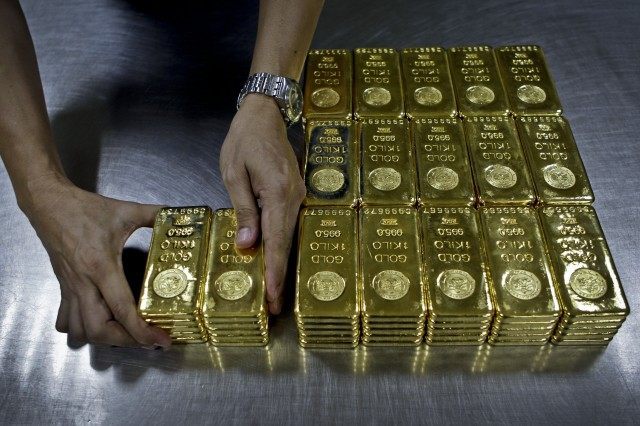Judy Shelton, Ph.D. closed out the conservative Jackson Hole Summit this past weekend by offering a practical pathway to re-restore the U.S. dollar as a gold-backed currency without economic disruption by having the Fed pledge about 7 percent of America’s gold in Fort Knox as collateral to issue gold-convertible Treasury Bonds.
Dr. Shelton argued that by allowing the U.S. monetary system to be administered by a group of supposed experts, the policies they implement will better serve the interests of the experts than those of the American people. She believes Americans want their money to function as a useful tool for measuring value, not as the means through which government attempts to implement economic and social policy.This is especially true, if that social policy primarily benefits crony capitalists.
Shelton further argues that since 1970, the Federal Reserve’s central planning has resulted in 90 percent of Americans seeing no inflation-adjusted income growth, while the top 10 percent of Americans saw their inflation-adjusted income more than tripled. Many economists believe the reason the top 10 percent have benefited is because they have the resources to game the Fed’s monetary policies to maximize their own returns.
Nobel Prize-winning economist Paul Krugman praises the 1950s and 1960s as the time when America was at its best, with a strong middle-class and lower income inequality. But he tries to ignore the fact that Bretton Woods system for monetary and exchange rate management from 1947 to 1971 featured the U.S. dollar as a gold-backed reserve currency that required the U.S. dollar to be exchangeable into gold. Nevertheless, Krugman regularly writes in his New York Times op-eds of his disdain for any consideration of gold-linked money as a return to a barbaric relic.
French economist Thomas Piketty, in his book lamenting the rise of income-inequality, Capital in the 21st Century, also describes the two decades from 1950 to 1970 as the “golden age of growth for Europe.” But he never mentions in his 700 page book the near-perfect correlation between this golden age of growth and the U.S. dollar as a gold-backed reserve currency. Piketty’s income inequality only ballooned after President Nixon supposedly took the U.S. dollar temporarily off the gold-standard in 1971.
Dr. Shelton highlights that during the years leading up to the 2008 Global Financial Crisis that without a gold-backed dollar, we had economic “volatility, persistent imbalances, disorderly capital movements, currency misalignments, currency wars and capital controls.” In her opinion, the record demonstrates that “[w]e had no system.” She advocates moving back to the gold standard to curtail dysfunctional monetary policies that rely on the whims of a group of establishment insiders.
Shelton does acknowledge that many who would support a gold-standard worry that “central banks are so firmly entrenched as agencies of government, headed by government-appointed officials, with near-total discretionary authority, that forging an alternative approach or even putting modest restraints on their power is difficult.” To counter concerns that such a move would cause serious short-term economic disruption, she suggests that a free-market path toward sound money could be forged through a set of painless intermediate steps that would involve no economic risks.
The United States has a reported 644 million troy ounces of gold in its various depositories, including at Ft. Knox and the New York Federal Reserve branch. The current value of that gold is a little more than half of the $1.33 trillion in U.S. paper currency (Federal Reserve Notes) in circulation. Dr. Shelton suggests that the U.S. Treasury issue the equivalent of 44 million ounces of “gold-convertible” Treasury bonds. The bonds would be equivalent to regular 5-year Treasuries, but the face value would be redeemable at the option of the bondholder into dollars or a fixed amount of gold. Bondholders would gain protection from losing purchasing power, and the government would be able to pay much lower interest costs.
Shelton believes the beauty of a gold-convertible Treasury bond in the marketplace is that it would quickly move up in price as regular Treasury bonds fall every time the Fed tried to finance deficit-spending and other games that debase the currency. That would alert the public and make it wildly difficult for Congress and the Fed to engage in such actions.
The organization that would object to the most to gold-convertible sovereign bonds is the International Monetary Fund, Shelton says. “After Bretton Woods ended in 1971, the IMF changed its rules to allow members to do anything they want on exchange rates: float, join a currency bloc, peg to a basket of currencies, whatever. The one exception is that IMF members are not allowed to peg their currency to gold.”
Dr. Shelton closed the conference with a story about having next to Milton Friedman at the Stanford’s Hoover Institution in the 1990s. Friedman blamed the “large, sometimes violent movements in exchange rates” with government interventions that became possible after the U.S. abandoned the gold standard in 1971. Friedman concluded: “A true gold standard–a unified currency–is indeed consistent with free trade.”

COMMENTS
Please let us know if you're having issues with commenting.